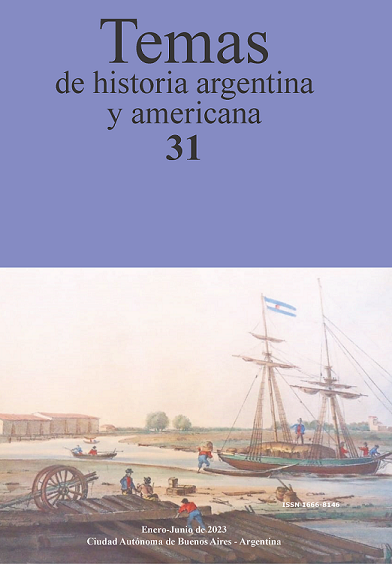Mortality and quality of life in Viceregal Salta: an analysis through death certificates (1766-1809)
DOI:
https://doi.org/10.46553/THAA.31.1.2023.p9-42Keywords:
18th century, Salta, Mortality, Quality of life, PopulationAbstract
In societies of the Ancient Regime, death was a process that involved a preparation deeply rooted in the traditions and customs of individuals with a Catholic mentality characteristic of the Hispanic Monarchy. These rituals were recorded in death records. The objective of this article is to conduct a meticulous survey and analysis of all available death records in the Archive of the Archbishopric of Salta, covering the period between 1766 and 1809. The study aims to unravel the dynamics of mortality, health, and well-being of the urban population in this city, within a context marked by political, civil, and institutional changes and transformations. The goal is to reconstruct the number of burials per year and their relationship with specific conjunctural situations, as well as to identify the socio-economic profile of the deceased, including their age, marital status, and place of origin. Additionally, it seeks to determine the main causes of death in this context, characterized as a "demographic Ancient Regime". By addressing these issues, the importance of death records as primary sources is emphasized. By complementing them with other documentation such as notarial protocols, municipal records, and judicial registers, we can obtain a more comprehensive understanding of mortality, quality of life, and their interrelation with social, cultural, and economic aspects of the inhabitants of the city of Salta.
Downloads
References
Acevedo, Edberto. «Establecimiento de la Intendencia.» En La intendencia de Salta del Tucumán en el Virreinato del Río de la Plata, de Edberto Acevedo, 110-162. Mendoza: Universidad Nacional de Cuyo, 1965.
AHS, Sección Judiciales. Juzgado de 1° Instancia en lo Civil. Exp. 1.
Anachuri, Marcelo Gabriel. «Créditos y fortunas. El caso de Juan Antonio Moldes en la Salta de fines del siglo XVIII.» América Latina en la Historia Económica 26, nº 3 (2019).1-25.
Anachuri, Marcelo Gabriel. «Salta, tierra de oportunidades a finales del siglo XVIII: "de criados a empresarios virreinales y funcionarios reales.» Revista de la Escuela de Historia 17, nº 1 (2018): 1-23.
Aramendi, Bárbara. «Gobierno y administración en el Tucumán, segunda mitad del siglo XVIII.» En La antigua gobernación del Tucumán: política, sociedad y cultura: S. XVI al XIX, de Ana Mónica González Fasani y Alejandro Nicolás Chiliguay Guillermno Nieva Ocampo, pp. 442. Salta: Milor, 2020.
Archivo y Biblioteca del Arzobispado de Salta, Parroquia La Merced; acta de defunciones.
Astrada, Luisa Miller. «El perfil de los grupos sociales.» En Salta hispánica. Estudio socio-económico desde el siglo XVI hasta la primera década del siglo XIX, de Luisa Miller Astrada, 85-158. Buenos Aires: Ediciones Ciudad Argentina, 1997.
Benito, Julia Pavón. «La muerte en la Europa Occidental. Trayectoria historiográfica.» Anuario de Historia de la Iglesia, 2003: 377-379.
Boucekkine, Raouf, David de la Croix, and Omar Licandro. «Early mortality declines at the dawn of modern growth.» The Scandinavian Journal of Economics, 2003: 401-418.
Caretta, Gabriela e Isabel Zacca. «Lugares para la muerte en el espacio meridional andino, Salta en el siglo XVIII.» Memoria americana, 2007: 135-154.
Caretta, Gabriela, e Isabel Elicea Zacca. «La muerte y sus indicios. Salta: ciudad y frontera en 1730.» Andes, 2010.
Caretta, Gabriela. «"Se habían vestido de hábitos clericales". La inclinación al estado eclesiástico como construcción social de la vocación en el Tucumán colonial.» Tiempo Histórico, 2012: 105-120.
Collado, Ángel Fernández. Historia de la Iglesia en España. La Edad Moderna. Madrid: Instituto Teológico San Ildefonso, 2007.
Concolorcorvo. El lazarillo de ciegos caminantes. Desde Buenos Aires hasta Lima 1773. Buenos Aires: Ediciones Argentinas Solar, 1942.
Cruz Montalvo, Olga Marcela. «Expresiones de la locura en el virreinato de la Nueva Granada durante el siglo XVIII.» Frenia. Revista de Historia de la Psiquiatría, 2011: pp. 47-66.
Frías, Susana y Montserrat, María Inés. «Pestes y muerte en el Río de la Plata y Tucumán (1700-1750).» Temas de Historia Argentina y Americana, 2017: 29-59.
Frías, Susana. «Introducción a dossier.» Temas de historia argentina y americana, 2020: 8-12.
Hernández, Yanina Mariel. «Temiéndome de la muerte que es cosa natural a toda criatura…”. Una aproximación a las sensibilidades mortuorias. (Ciudad de Salta. Siglo XVIII).» Boletín americanista, 2011: 35-50.
Jiménez, Pablo Rodríguez, y María Emma Manarelli. Historia de la infancia en América Latina. Externado: Universidad Externado, 2007.
Justiniano, María Fernanda, Madregal, Carina y Anachuri, Gabriel. «Juan Antonio Moldes: De criado a comerciante global y funcionario regio (Salta, Buenos Aires, Cádiz, Filipinas, 1764-1804).» Revista de Indias 79, nº 276 (2019): 433-457.
Justiniano, María Fernanda. «De las sustancias a las relaciones, de la política dirigida por reglas, a la política modificadora de reglas. Aportes de la nueva historiografía para el estudio de Salta y la región en el siglo XIX.» Revista de la Escuela de Historia, 2014: 1-28.
León, Marco. «La memoria y sus espacios: Entierros, Ceremonias Fúnebres y Estrategias para alcanzar el «Más allá» en Santiago de Chile Colonial.» Revista Notas Históricas y Geográficas, 2021: 21-55.
López, Cristina. «El espacio y la gente: la dinámica sociodemográfica de la población del Tucumán tardo y poscolonial.» Andes, 2006: 239-264.
Martín, María Azpeitia. «Historiografía de la Historia de la muerte.» Studia Historica, Historia Medieval, 2008: 113-132
Martínez, Alcira Dueñas. «Mujeres coloniales al filo de su muerte: economía y cultura en los testamentos de mujeres de Pasto a fines del siglo XVIII.» Tendencias, 2000: pp. 145-147.
Mata, Sara. «La rebelión de Tupac Amaru y el noroeste argentino.» Andes. Antropología e Historia, 2022: 1-25.
Mata, Sara. «Los comerciantes de Salta a fines del siglo XVIII.» Anuario de la Escuela de Historia, 1994: 189-211.
Mata, Sara. «Los señores de la tierra. Riqueza, estatus y poder.» En Tierra y poder en Salta. El noroeste Argentino en vísperas de la Independencia, de Sara Mata, pp. 212-213. Sevilla: Diputación de Sevilla, 2000.
Mata, Sara. «Población y producción en la jurisdicción de Salta a fines del período colonial.» Andes, 1998: 143 - 169.
Mata, Sara; Zacca, Isabel; Marchionni, Marcelo y Caretta, Gabriela. «La sociedad urbana de salta a fines del periodo colonial.» Cuadernos de Humanidades, 2018: 1-24.
Montserrat, María Inés y Frías Susana. Pestes y muerte en el Río de la Plata y Tucumán (1700-1750). Buenos Aires: Universidad Católica Argentina. Facultad de Ciencias Sociales, Políticas y de la Comunicación. Instituto de Historia Argentina y Americana, 2017.
Otero, Hernán. «De la demografía histórica a la historia de la población.» En Poblaciones históricas. Fuentes, métodos y líneas de investigación, de Mónica Ghirardi y Adrián Carbonetti (coord) Dora Celton, 13-42. Río de Janeiro: Asociación Latinoamericana de Población, 2009: 13.
Pozaglio, Fernando Ariel. «La venta y el nombramiento de oficios en el cabildo de Corrientes desde fines del siglo XVII y primera mitad del siglo XVIII.» Folia Histórica del Nordeste, 2012: 93-116.
Pozzaglio, Fernando Ariel. «Las actas de defunciones como fuentes para el estudio de la muerte y la sociedad de Corrientes colonial. 1780-1800.» Temas de historia argentina y americana, 2020: pp. 67-68.
Prieto, Mayra Espina. «Complejidad y pensamiento social.» Revista Complexus, 2005: 77.
Roca, Facundo. «Prácticas funerarias y lugares de entierro en el Buenos Aires tardo-colonial: un estudio sobre la parroquia de Nuestra Señora de Montserrat.» Andes, 2019: 1-28.
Ruiz, Jorge Comadrán. Evolución demográfica argentina durante el período hispano (1535-1810). Buenos Aires: Universitaria, 1969.
Salas, Adela. «Nuevos aportes para la historia colonial rioplatense: la población.» Épocas, 2007: 1-25.
Socolow, Susan. «Mujeres, metrimonio y familia.» En Las mujeres en la América Latina colonial, de Susan Socolow, 77-96. Buenos Aires: Prometeo, 2016.
Vovelle, Michel. «Historia de la muerte.» Cuadernos de Historia, 1998: 37-49.
Zavala, Graciana Pérez, and Marcela Tamagnini. «Dinámica territorial y poblacional en el Virreinato del Río de la Plata: indígenas y cristianos en la frontera sur de la gobernación intendencia de Córdoba del Tucumán, 1779-1804.» Fronteras de la Historia, 2012: 195-225.
Downloads
Published
How to Cite
Issue
Section
License
Copyright (c) 2023 Marcelo Gabriel Anachuri

This work is licensed under a Creative Commons Attribution-NonCommercial-ShareAlike 4.0 International License.





























